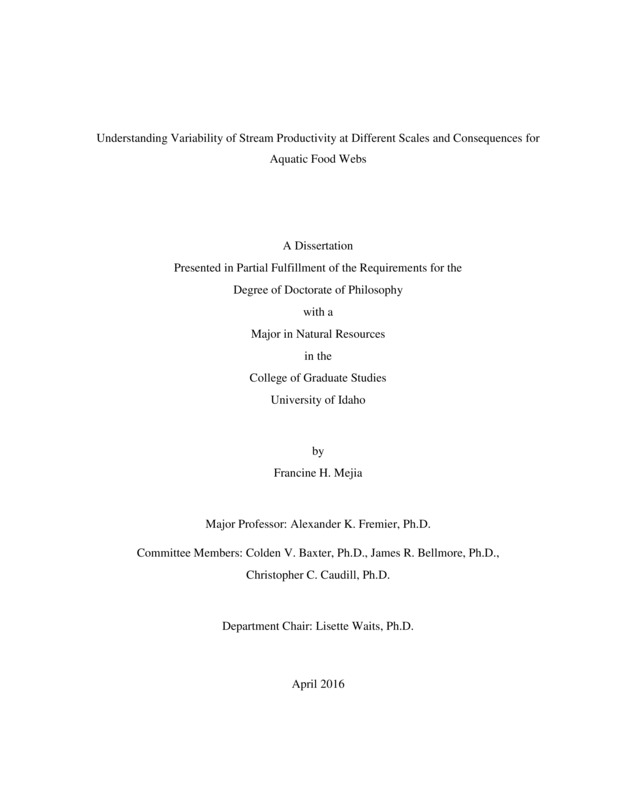Understanding Variability of Stream Productivity at Different Scales and Consequences for Aquatic Food Webs
Mejia, Francine Harriet. (2016). Understanding Variability of Stream Productivity at Different Scales and Consequences for Aquatic Food Webs. Theses and Dissertations Collection, University of Idaho Library Digital Collections. https://www.lib.uidaho.edu/digital/etd/items/mejia_idaho_0089e_10859.html
- Title:
- Understanding Variability of Stream Productivity at Different Scales and Consequences for Aquatic Food Webs
- Author:
- Mejia, Francine Harriet
- Date:
- 2016
- Embargo Remove Date:
- 2017-05-12
- Keywords:
- ecosystem respiration gross primary production groundwater metabolic theory salmon rearing stream metabolism
- Program:
- Natural Resources
- Subject Category:
- Aquatic sciences; Ecology; Environmental science
- Abstract:
-
Streams and rivers are dynamic systems that vary over space and time. Understanding the relationship of spatial and temporal heterogeneity to ecosystem functions such as gross primary productivity, ecosystem respiration and growth is critical so we can understand and predict the consequences of human impacts on spatial and temporal patterns of lotic systems. These modifications have the potential effect of homogenizing and simplifying stream and river networks. I aimed to understand how the spatial organization and temporal patterns of a stream network affect stream productivity at different trophic levels. Chapter 2 focused on how the network spatial organization and temporal patterns influence groundwater inputs and subsequently how areas of active groundwater-surface water exchange may have an influence on the productivity of multiple trophic levels (i.e. post emergent salmon, benthic invertebrates, and periphyton biomass). Chapter 3 described the spatial and temporal patterns of stream metabolism at the reach and network scales. I also discussed the influences of these patterns on higher trophic levels and the implications on management, planning conservation and restoration efforts. Lastly, in Chapter 4, I used metabolic theory concepts to predict variation on the relationship between stream temperature and periphyton biomass and stream metabolism across the network. These findings highlight how stream networks may play a role in the global carbon cycle as increasing global surface temperatures have been associated with climate change. Each chapter focused on different temporal and spatial scales because to evaluate biological responses, ecological relevance must be taken into account to select the appropriate spatial and temporal scale. For example, post-emergent salmon were more likely to operate at a smaller (spatial) narrower (temporal) scale than stream metabolism. Thus, study designs reflected this to match the scale of observation with the scale of response.
- Description:
- doctoral, Ph.D., Natural Resources -- University of Idaho - College of Graduate Studies, 2016
- Major Professor:
- Fremier, Alexander K
- Committee:
- Caudill, Christopher C; Baxter, Colden V; Bellmore, James R
- Defense Date:
- 2016
- Identifier:
- Mejia_idaho_0089E_10859
- Type:
- Text
- Format Original:
- Format:
- application/pdf
- Rights:
- In Copyright - Educational Use Permitted. For more information, please contact University of Idaho Library Special Collections and Archives Department at libspec@uidaho.edu.
- Standardized Rights:
- http://rightsstatements.org/vocab/InC-EDU/1.0/

